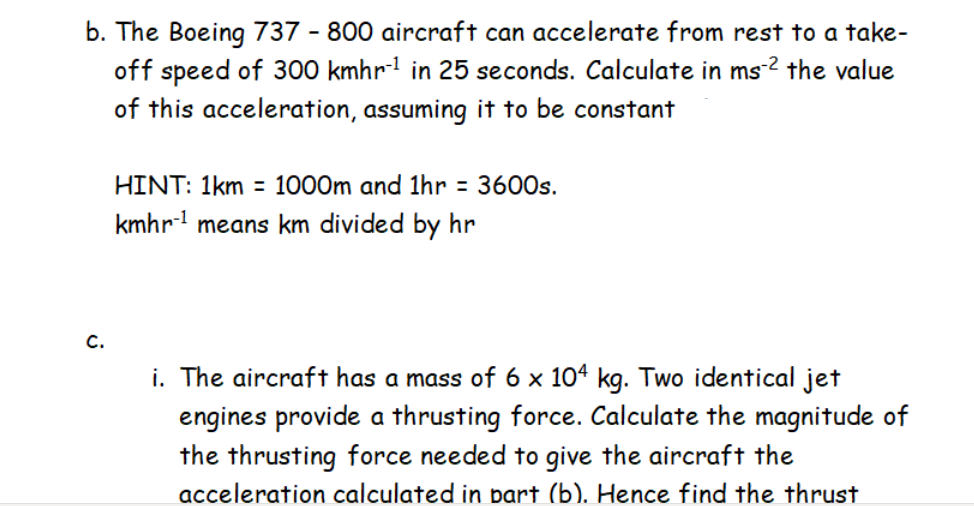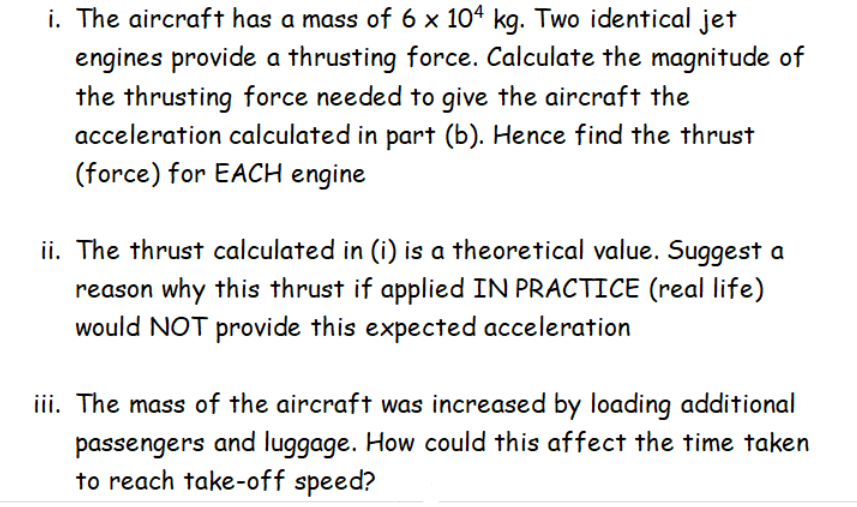I need help with part C (ii and iii)
International Edition---engineering Mechanics: Statics, 4th Edition
4th Edition
ISBN:9781305501607
Author:Andrew Pytel And Jaan Kiusalaas
Publisher:Andrew Pytel And Jaan Kiusalaas
Chapter1: Introduction To Statics
Section: Chapter Questions
Problem 1.19P: Plot the earths gravitational acceleration g(m/s2) against the height h (km) above the surface of...
Related questions
Question
I need help with part C (ii and iii)

Transcribed Image Text:b. The Boeing 737 - 800 aircraft can accelerate from rest to a take-
off speed of 300 kmhr- in 25 seconds. Calculate in ms-2 the value
of this acceleration, assuming it to be constant
HINT: 1km = 1000m and 1hr = 3600s.
kmhr means km divided by hr
C.
i. The aircraft has a mass of 6 x 104 kg. Two identical jet
engines provide a thrusting force. Calculate the magnitude of
the thrusting force needed to give the aircraft the
acceleration calculated in bart (b). Hence find the thrust

Transcribed Image Text:i. The aircraft has a mass of 6 x 104 kg. Two identical jet
engines provide a thrusting force. Calculate the magnitude of
the thrusting force needed to give the aircraft the
acceleration calculated in part (b). Hence find the thrust
(force) for EACH engine
ii. The thrust calculated in (i) is a theoretical value. Suggest a
reason why this thrust if applied IN PRACTICE (real life)
would NOT provide this expected acceleration
iii. The mass of the aircraft was increased by loading additional
passengers and luggage. How could this affect the time taken
to reach take-off speed?
Expert Solution
This question has been solved!
Explore an expertly crafted, step-by-step solution for a thorough understanding of key concepts.
Step by step
Solved in 4 steps

Knowledge Booster
Learn more about
Need a deep-dive on the concept behind this application? Look no further. Learn more about this topic, mechanical-engineering and related others by exploring similar questions and additional content below.Recommended textbooks for you

International Edition---engineering Mechanics: St…
Mechanical Engineering
ISBN:
9781305501607
Author:
Andrew Pytel And Jaan Kiusalaas
Publisher:
CENGAGE L

International Edition---engineering Mechanics: St…
Mechanical Engineering
ISBN:
9781305501607
Author:
Andrew Pytel And Jaan Kiusalaas
Publisher:
CENGAGE L